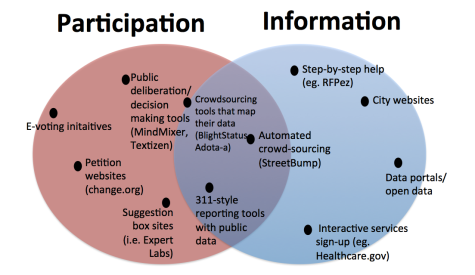While organizations like the Knight Foundation have begun to chart the field of civic tools, the designations are often assumed to be apolitical and merely representational of the genres of tools that exist in the space. But as the area of civic media begins to get more attention and such tools are increasingly the subject of (warranted!) criticism from academics (myself and Eric Gordon, Dan Kreiss, Jenny Stromer-Galley, and Jim Katz have all written about how pseudo-engaging tools are being adopted in campaigns and in governance).
As governments adopt ICTs as a way to improve service delivery and meet the needs of their communities, the very use of such tools also implicitly—and sometimes explicitly—sheds light on the democratic values encouraged or emphasized. For instance, a tool designed with the goal of streamlining intra-governmental communications or practices values efficiency; open data initiatives value transparency and an informed citizenry; calls for online town halls value deliberative practice and a governing institution that solicits feedback from its citizens. Although these projects share broad goals of improving governance, information-related goals differ from those that are engagement-focused. As a result, a categorization scheme that attends to this information/participation continuum helps better illuminate the democratic norms upheld and furthered by such tools. Even just looking at emerging media in a civic, non-campaign setting, the landscape of tools begins to look like:
While these designations are not cut and dry—open data programs can also value the idea of community members using data to create their own information or interaction—there are dominant values that are both implicitly and explicitly embedded into cutting edge uses of ICTs. Although these projects share broad goals of improving governance, information-related goals differ from those that are participation-focused. On the participatory end, tools embody ideals similar to those of “strong democracy,” moving away from “thin” forms of participation that leave citizens on the periphery of their own governance, and bringing citizens back into actively engaging in the policy-making process. On the information side of things, however, we see different norms. By focusing on using ICTs s a way to make information more available and navigable, initiatives and tools that focus on open data and transparency highlight citizens’ primary role as one of becoming and maintaining an informed status. As a result, the normative vision of citizenship that such efforts project is one that is focused on becoming and/or maintaining an informed status. While I tend to focus on how to move from the right side of this continuum to the left, simply beginning to chart tools in such a manner can illuminate the normative implications of the current civic landscape and raise questions about where we want to be.
